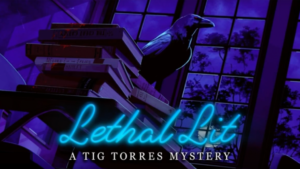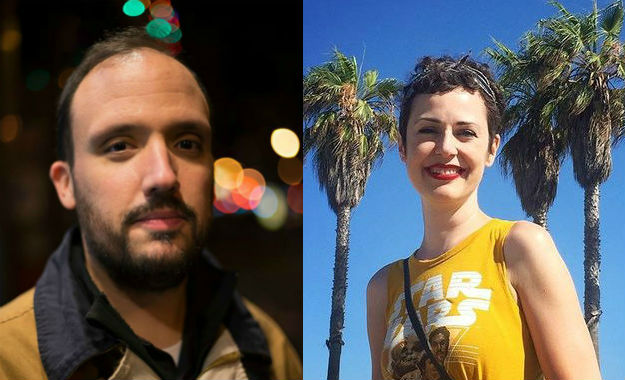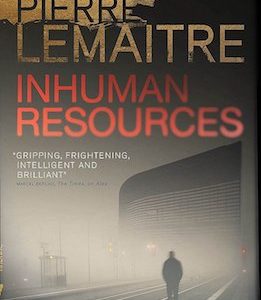These are boom days for the podcasting world, with an emerging consensus pointing toward the next frontier: the scripted podcast. Following the breakout success of series like Limetown and Homecoming, more writers and creators are bringing their fictions to our download queues and banking on the long and beloved tradition of audio mysteries, now in an easy to digest, commute-ready form. The latest mystery poised for breakout success is Lethal Lit, a co-production from podcast veterans Einhorn’s Epic Productions (EEP) and iHeart Radio, written by Alex Segura and Monica Gallagher.
Lethal Lit is a fictional riff on the true crime podcast format we all know and love, featuring a teen podcaster named Tig Torres and a team of A/V savvy high schoolers chasing down leads on a murder case in their small-town. Tig is the niece of a convicted murderer, but she’s determined to clear her family’s good name and, through her investigative podcast, prove that the real killer is still out there, leaving clues in works of classic literature and benefiting from a coverup that reaches all corners of the tight-knit community.
It’s a heady story with a powerful figure at the center—and an innovative new format for mystery fiction. So we decided to reach out to the show’s writers, Alex Segura and Monica Gallagher, to discuss the brave new world of podcasting, why the fundamentals of crime translate into all formats, and creating characters to connect with a new generation of mystery lovers.
These are still the early days of scripted podcasts, and while you’ve both worked in other media, this is your first crack at writing crime fiction for this format. What kind of storytelling challenges did podcasting present?
Alex Segura: Monica and I both do comics and I also write novels, and each medium has a different way of “speaking” to the reader—comics are purely visual. You look at the images and process them, then read the text to complement the image. With novels, it’s all internal and really left to the imagination of the reader. Podcasts are completely different. You’re relying completely on the auditory—you have to define every action and every meaningful moment through sound. Simple in theory, much harder in practice—you have to verbally introduce characters, show action and movement with sound and also continually remind yourself that the people engaging with the show don’t have pictures or video to help explain what you’re trying to say or explain.
Monica Gallagher: It was a reminder that with every new creative project, you have a specific toolset in which to tell your story. The aspects of creating character development and plot structuring begin the same way, and then it’s just tackling the challenge of which tools you can/can’t rely on to get the story across in the chosen medium.
AS: Yeah, It was a really interesting and new way to work, and I’m glad we both had a background in comics—which are extremely collaborative and all about back and forth—because I think otherwise it would have posed a greater challenge. We had a really supportive production team behind us, lead by Heather Einhorn and Adam Staffaroni at Einhorn’s Epic Productions, and a killer team at iHeart Media that were supportive and responsive to the work. I think, at the end of the day, story is story—but it becomes a question of how do you make sure your story is utilizing the tools of the medium. So, while in a novel I might interject scenes of internal monologue or really get into a character’s head, it’s different for a podcast, and you have to rely on the narration and dialogue to tell listeners what’s going on.
MG: Without, you know, just flat out writing things for the actors to say like: “Hey character who just entered the scene, put down that knife you have pointed at me!”
AS: Exactly! Overall, it was a really fun and entertaining format, and I hope we get to do more of it.
Your heroine here, Tig Torres, derives from a new kind of archetype—the crusading podcaster. But she has a very different background, one we don’t see much of in mystery fiction or in podcasting (both of which often struggle to find diverse heroes/heroines). How did you develop who Tig was and what drives her?
AS: When Lethal Lit executive producers and co-creators Heather Einhorn and Adam Staffaroni approached me about the podcast, we knew a few things—we wanted a strong, female lead and we wanted her to be Latinx. I’ve said this a lot when discussing the Pete novels and why I was driven to write them, but it boils down to this: I wanted to read a mystery novel that starred someone like me. With my background. I think we have enough steel-jawed white guys running around saving the day and getting the girl. And the EEP team felt the same way. They want to introduce strong, diverse characters, and that really resonated with me and Monica. I think Tig is both new and classic—she features traits from some of my favorite fictional characters, but is very much of the moment. She has elements of Sherlock Holmes, Buffy, Veronica Mars, Peter Parker/Spider-Man and much, much more. We wanted Tig to feel real and conflicted, but also extremely focused and capable—she’s extremely smart, driven and won’t humor fools. She will push forward on her mission no matter what, but she’s also a teenager dealing with the stuff that comes with growing up. We meet her at a really important moment—when she discovers she has the chance to solve the case that’s haunted her—and her family’s—lives for a decade. It’s a galvanizing thing, and we basically get to see Tig go from true crime fan to becoming an actual hero. If she survives, that is.
It’s always fun to write for characters who pull from a variety of characteristics and exhibit them in different ways—that’s what it means to be complex, rather than just “strong” or “weak.”MG: To quote Phoebe Robinson’s fantastic podcast: “Sooo Many White Guys”! We wanted Tig to be a complex character who was a collection of different influences, which came across in her motivations and behavior. So she could be a teenager who is still evolving in terms of her sense of self and encountering new emotions, while carrying with her the history of her experiences growing up Latina in a family with a dark past, while also being a classic noir hero, obsessed with and driven by her particular mission. It’s always fun to write for characters who pull from a variety of characteristics and exhibit them in different ways—that’s what it means to be complex, rather than just “strong” or “weak.”
The crime and mystery community is often fretting over how to reach young people—new fans, new readers. That’s something you’re both experienced in with your writing careers, and with Lethal Lit you’re targeting those young people in a really interesting way. What do you think of as the keys for connecting with a younger audience, especially when it comes to mystery?
AS: I think the elements of mystery—and good fiction—hold true. It’s kind of timeless. Tell a good story, with interesting twists and great characters, and you’re in solid shape. Much easier said than done. But in terms of reaching young people—I think part of it is telling stories that involve them. Not just as the sidekick or petulant hid to the established hero. Lethal Lit is about Tig, but it’s also about her new friends, their dynamic, drama and relationships, without being salacious or cheesy. The way they play off each other feels very organic and honest, which was something we really strove for. We didn’t want it to read or sound like a bunch of older people trying to sound hip and sexy. First and foremost, we wanted to tell a story about these talented, diverse and kickass teenagers taking action where the adults couldn’t. That’s something anyone can relate to.
MG: I think it’s always important to give an audience a way in, something they can discover and own and feel a part of. It helps when you have diverse characters—especially for younger audiences who may not see themselves represented very often in media. But it’s also about not talking down to them. So we were trying to write in a style that drew from crime stories while incorporating some sassy dialogue that younger audiences are more familiar with—all while still hopefully not sounding too “old person doing teen speak.” 
The death of the local newspaper and the rise of amateur podcast sleuths is an interesting strand to Lethal Lit—a big part of your fictional cold case. Do you see podcasters today, especially the young DIY crime podcasters like Tig, as inheriting some part of an investigative tradition, or stepping into a vacuum of a sort?
Tig is definitely joining that pantheon of enterprising journalist/crime fiction hero, just with her own twist—characters like Lois Lane, Tess Monaghan…AS: I think there’s always a hunger for in-depth, comprehensive reporting, and with newspapers evolving— sometimes dying—we have seen a definite uptick in those stories popping up as podcasts, whether it’s true crime like Serial, S-Town, Dirty John or stuff that focuses on other aspects of life. People want to be informed and are hungry to learn, #fakenews be damned. But yes, Tig is definitely joining that pantheon of enterprising journalist/crime fiction hero, just with her own twist—characters like Lois Lane, Tess Monaghan and so on, were huge inspirations and are part of Tig’s DNA, for sure.
MG: I love how new tech is revisiting and enhancing old tech and giving the younger generation a way to explore and become investigators in their own right. In that way, newspapers and radio dramas never really die, they just get claimed by a new generation. There is so much you can do with podcasting, and I love the added depth of calling on old/outdated/expired medium to enhance current stories. I think we’re going to keep seeing more and more done with podcasting, which is super exciting.
Classic literature is central to the story you’re telling here. Just in the first few episodes, Lord of the Flies, A Clockwork Orange, “The Lottery,” and Crime and Punishment all come into play. There’s something thrilling about the idea of finding clues in all these seminal works we’ve all read. How did you choose the texts that were going to supply your clues? Was it fun playing around with these important literary works, even in a bit of a morbid way?
AS: We wanted the choices to ring true, and also feel like the kind of books you had to read in high school. I did a ton of research on what is being taught in English classes in schools today, mixed it in with a list I made based on the books I read during my own high school years, a few centuries back. From there, we chose books that featured compelling scenes and dug up quotes…It was fun, I have to say, because it basically meant we were putting a puzzle together to then share with the public, hoping they were engaged enough with the clues but also not immediately able to figure it out. It’s my hope that, in some way, the show turns people on to these great books by tying them into this story. It’s certainly made me reread books I hadn’t spent time with in decades!
Lethal Lit plays with a lot of tropes of the modern-day podcasting phenomenon. Are you both crime podcast fans? Any favorites that were in your mind as you wrote this story, or any that you think of as the podcasts that inspired Tig?
AS: Oh, for sure. I love true crime podcasts. My go-to is Crime Writers On, because I don’t really have time to keep up with every true crime thing, but they recap and comment on the genre so well. It’s a wonderful starting point. The first season of Serial was important to us, because we really wanted to echo Sarah Koenig’s human and honest voice, but also make it our own. Off the top of my head, I also really liked Crimetown, Criminal, Dirty John, Missing and Murdered: Finding Cleo, and The Long Dance. I’m also a pretty voracious true crime reader, and books like I’ll Be Gone in the Dark and The Grim Sleeper kept echoing in my head as we worked on this, as did documentaries like Making a Murderer and The Staircase.
MG: I’m actually completely new to true crime podcasts—my only past listening experience as we were evolving Tig was Serial, Limetown, and S-Town. But I’m a huge fan of podcasts and have been listening to a variety over the years, so it helped to keep a bunch in mind. From staged/scripted shows like Welcome to Night Vale and Thrilling Adventure Hour, to folklore/horror shows like Lore and Astonishing Legends, to local history shows like my own town of Baltimore’s The Noir and Bizarre. Listening to a variety has helped me a great deal in learning more about what’s possible with the podcasting medium, and all the fantastic (and creepy) places you can take it with your storytelling!


















